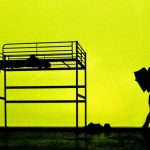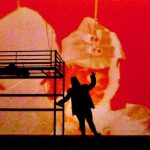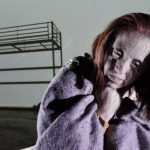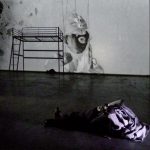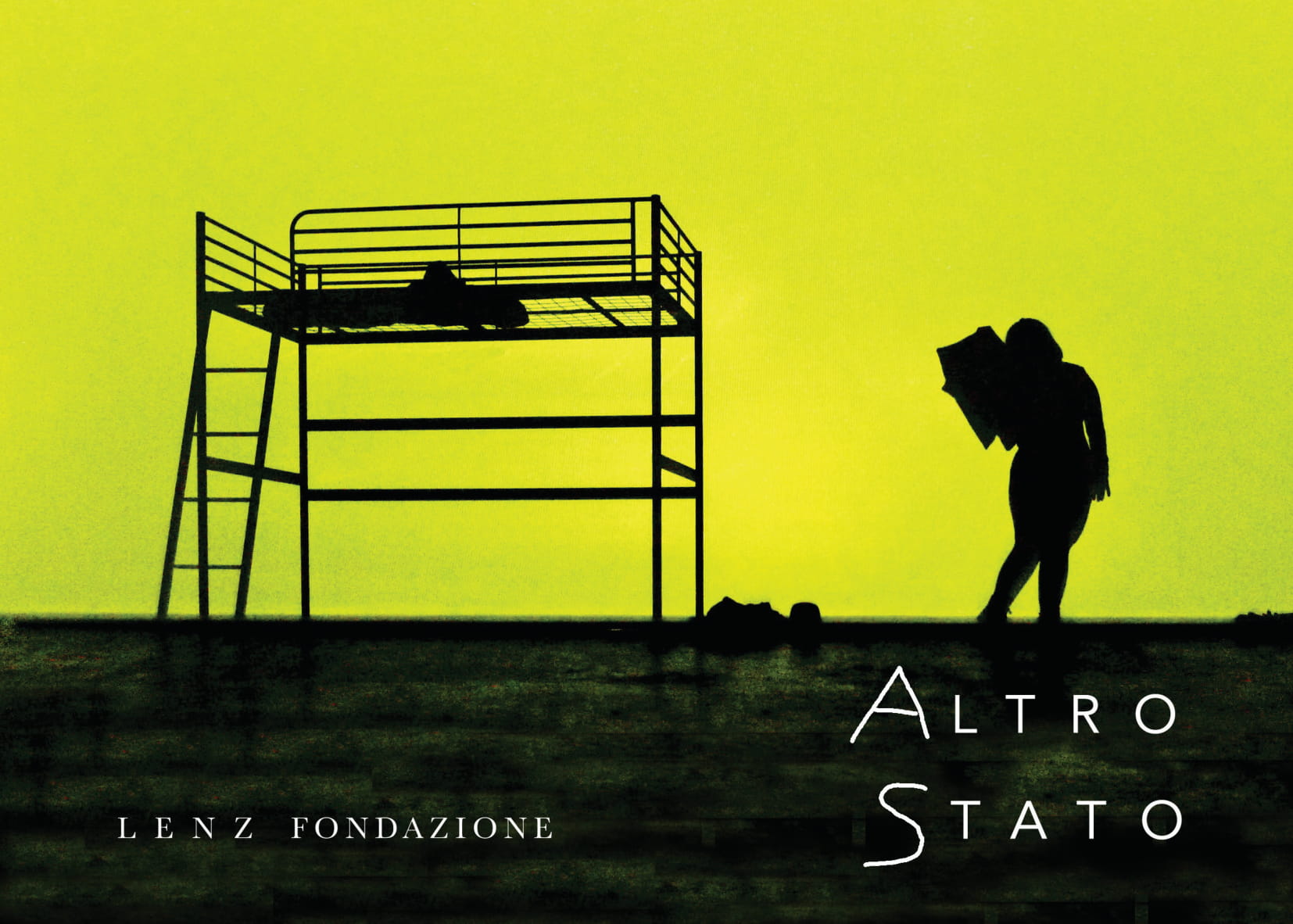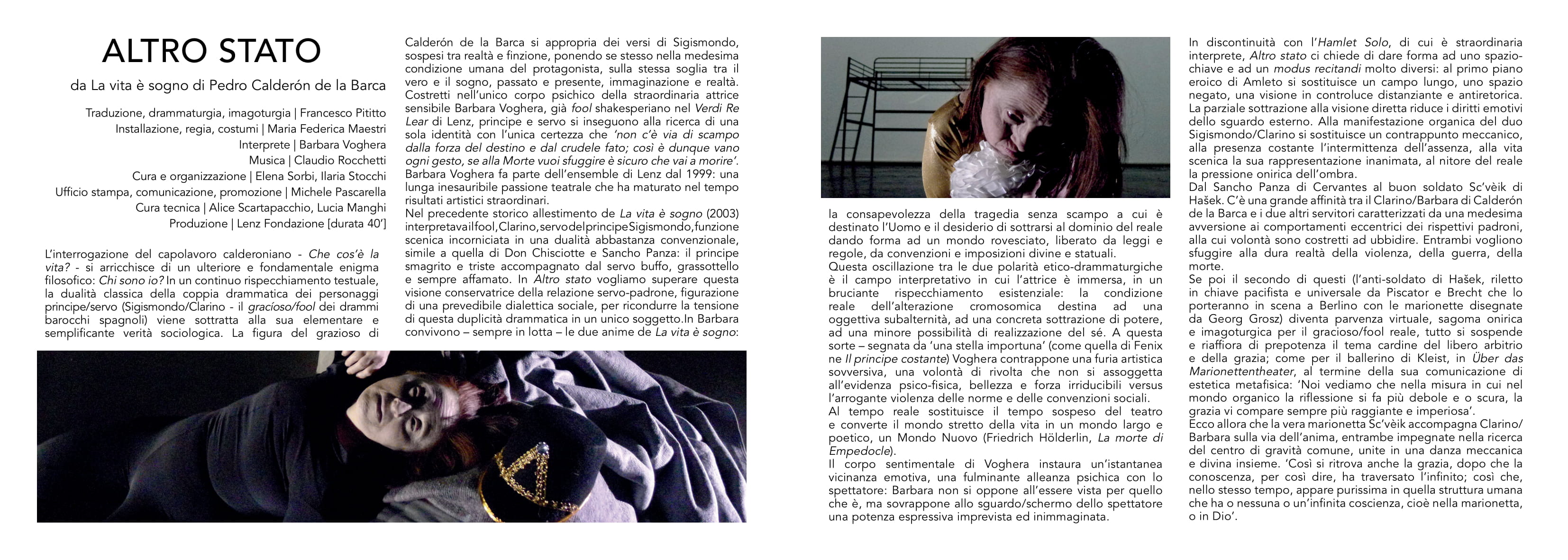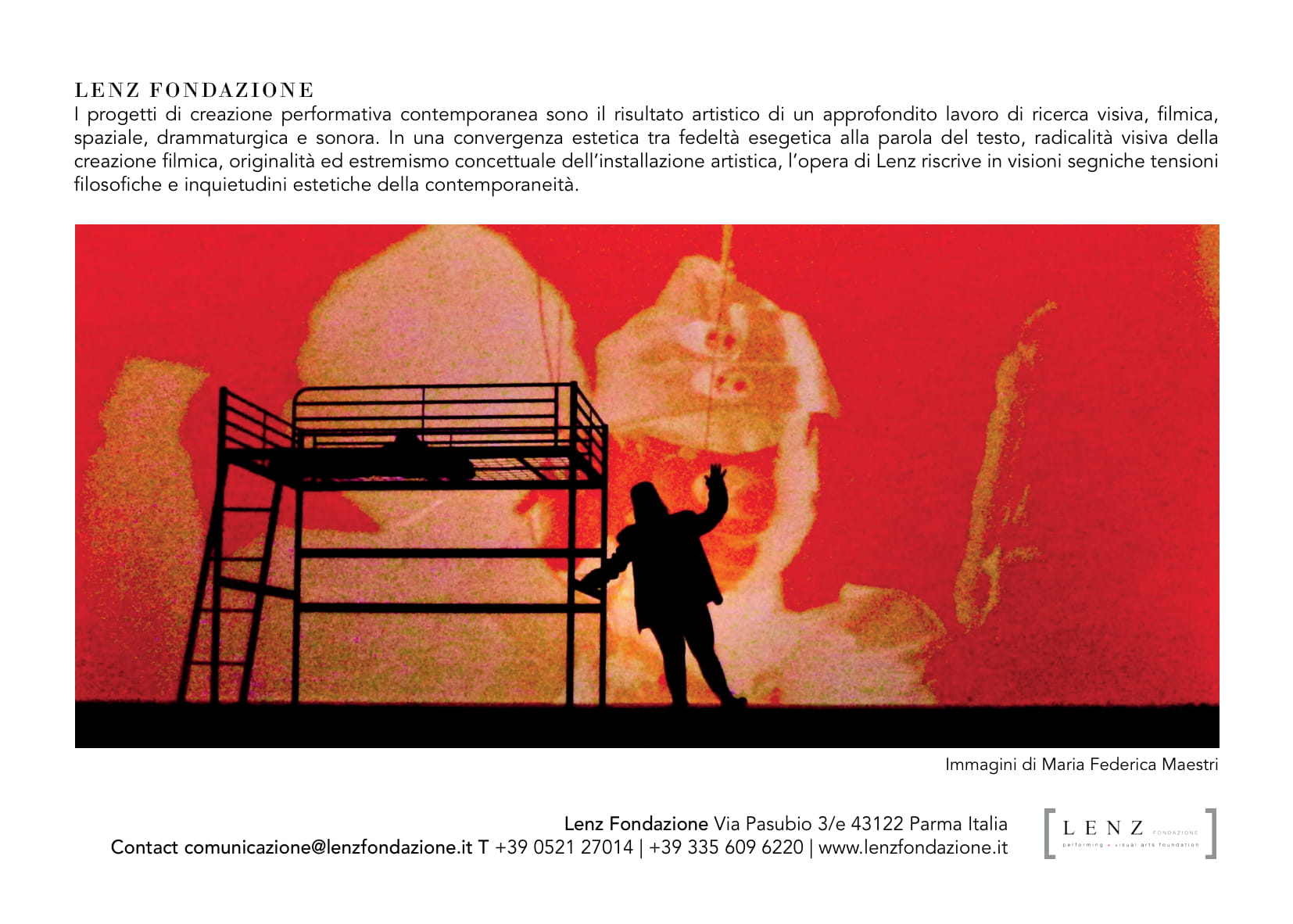
OTHER STATE
The questioning of Calderon's masterpiece – What is life? – is enriched by a further and fundamental philosophical enigma: Who am I?
In a continuous textual mirroring, the classic duality of the dramatic couple of prince/servant characters (Sigismondo/Clarino – il funny/fool of Spanish baroque dramas) it is taken away from its elementary and simplifying sociological truth.
Calderón de la Barca's figure of grace appropriates Sigismondo's verses, suspended between reality and fiction, placing himself in the same human condition as the protagonist, on the same threshold between reality and dream, past and present, imagination and reality.
Forced into the unique psychic body of the extraordinary sensitive actress Barbara Voghera, Already fool Shakespearean in Verdi Re Lear di Lenz, prince and servant chase each other in search of a single identity with the only certainty that ‘there is no escape from the force of destiny and cruel fate; so every gesture is in vain, if you want to escape Death it is certain that you are going to die'.
Barbara Voghera is part of the Lenz dal ensemble 1999: a long inexhaustible theatrical passion that has developed extraordinary artistic results over time.
In the previous historic staging of Life is a dream (2003) he played the fool, Clarino, servant of Prince Sigismund, scenic function framed in a fairly conventional duality, similar to that of Don Quixote and Sancho Panza: the gaunt and sad prince accompanied by the funny servant, plump and always hungry. In Other state we want to overcome this conservative vision of the master-servant relationship, figuration of a predictable social dialectic, to bring the tension of this dramatic duplicity back into a single subject. In Barbara the two souls coexist - always in conflict Life is a dream: the awareness of the inescapable tragedy to which Man is destined and the desire to escape the domination of reality by giving shape to an overturned world, freed from laws and rules, by divine and state conventions and impositions.
This oscillation between the two ethical-dramaturgical polarities is the interpretative field in which the actress is immersed, in a burning existential reflection: the real condition of chromosomal alteration destines to an objective subalternity, to a concrete subtraction of power, to a lesser possibility of self-realization. To this fate - marked by 'an importunate star' (like that of Fenix ne The constant prince) Voghera contrasts with a subversive artistic fury, a will to revolt that does not submit to psycho-physical evidence, irreducible beauty and strength versus the arrogant violence of social norms and conventions.
It replaces the suspended time of the theater in real time and converts the narrow world of life into a wide and poetic world, a New World (Friedrich Holderlin, The death of Empedocles).
Voghera's sentimental body establishes an instant emotional closeness, a lightning-fast psychic alliance with the spectator: Barbara does not object to being seen for who she is, but it superimposes an unexpected and unimagined expressive power on the viewer's gaze/screen.
In discontinuity with theHamlet Solo, of which she is an extraordinary interpreter, Other state asks us to give shape to a key-space and a mode of reciting very different: a long shot replaces Hamlet's heroic close-up, a denied space, a distancing and anti-rhetorical backlit vision. Partial removal from direct vision reduces the emotional rights of the external gaze. The organic manifestation of the Sigismondo/Clarino duo is replaced by a mechanical counterpoint, to constant presence the intermittency of absence, its inanimate representation to stage life, to the clarity of reality the dreamlike pressure of the shadow.
From Cervantes' Sancho Panza to Hašek's good soldier Sc'vèik. There is a great affinity between Calderón de la Barca's Clarino/Barbara and the two other servants characterized by the same aversion to the eccentric behavior of their respective masters, whose will they are forced to obey. Both want to escape the harsh reality of violence, of the war, of death.
If then the second of these (Hašek's anti-soldier, reread in a pacifist and universal key by Piscator and Brecht who will bring it on stage in Berlin with the marionettes designed by Georg Grosz) becomes virtual semblance, dreamlike and imagoturgical silhouette for the real graceful/fool, everything is suspended and the key theme of free will and grace forcefully resurfaces; as for Kleist's dancer, in About the puppet theater, at the end of his communication of metaphysical aesthetics: 'We see that to the extent that reflection becomes weaker and darker in the organic world, grace appears more and more radiant and imperious'.
Here then is the real puppet Sc'vèik accompanies Clarino/Barbara on the path of the soul, both engaged in the search for the common center of gravity, united in a mechanical and divine dance together. 'This is also how grace is found, after that knowledge, so to speak, he crossed the infinite; so that, at the same time, appears very pure in that human structure that has either no or infinite consciousness, that is, in the puppet, or in God'.
Barbara Voghera Since the beginning of the 2000s he has been the protagonist of some of Lenz's most important performance projects, central figure in the decades-long investigation by Maria Federica Maestri and Francesco Pititto on the renewal of contemporary scenic language through artistic dialogue with otherness.
Exceptional interpreter in the various drafts ofHamlet (included in the international archive Global Shakespeares from MIT – Massachussets Institute of Technology, authoritative recognition of Lenz's research on the sensitive actor), is a multifaceted presence in the trilogy dedicated to Faust by Goethe; extraordinary performer in the first version of Life is a dream by Calderón de la Barca in the role of Clarino, interpretation which was the subject of a study seminar as part of the most important Spanish Baroque Theater Festival, will be on stage again in the site-specific installation at the Pilotta Monumental Complex in Parma 2020 | Italian Capital of Culture.
Among the numerous other roles played in these twenty years of work, it is worth mentioning at least those starring in snow-white e Tom Thumb In the Grimm project (on tour in the major European capitals) and in Hand us over, girl, your eyes Taken from the work of García Lorca Cred snack; the Fool in the work Verdi Re Lear, special commission of the Verdi Festival 2015 and Bradamante in the two-year site-specific project inspired byOrlando Furioso of Ariosto. In the 2019 is on stage at the Teatro Farnese in Parma with Hamlet Solo, powerful solo in which Voghera gives body and voice to Shakespeare's masterpiece. In the 2019 plays Orestes in’Oresteia #2 Latte of Aeschylus.
OTHER STATE
and Life is a dream by Pedro Calderon de la Barca
Translation, playwriting, imagoturgy | Francesco Pititto
Installation, regia, costumes | Maria Federica Masters
Interpreter | Barbara Voghera
Musica | Claudius Rocchetti
Care and organization | Elena Sorbi, Ilaria Stocchi
Press office, communication, promotion | Michele Pascarella
Technical care | Alice Scartapacchio
Production | Lenz Foundation [Duration 40 ']
trailer:
whole wheat:
The challenge is to dissolve the theatrical circle. This is not an unprecedented operation, but Lenz Fondazione does it with extreme rigor. With humanity (or as if it rewrote the meaning of 'humanism') [more].
Mario Da Santis, Huffington Post
Beautiful images saturated with lights, in which puppets become giants and humans tiny, in a temporary but fantastic revolution.
Elena Scolari, Hystrio
Dramaturgical and performative scores that become a "bridge" between opposites: what, from Barbara Voghera's veiled vision behind a screen, brings the projection of his shadow to become “live”; or which leads the actress to "ferry" herself into a double role without ever being able to completely strip off her costume, thus moving virtuosity within a text suspended between reality and dream and remaining a person, character and puppet “animated” by heroic fury [more].
Daniele Rizzo, Persinsala
While Voghera plays Sigismondo so much that he wonders if he is acting freely, as much as Clarino who believes in freedom, the spectator sees represented in the background a marionette moved by invisible strings. The actress gradually becomes one herself: the invisible is transformed into the visible, metaphysics in physics [more].
Enrico Piergiacomi, Theater and Criticism
The traditional question about life, here he slides with extraordinary sensitivity and naturalness into the question about his own life, to one's own subjectivity, that precisely through the mirror and the reflection he can find a paradoxically more authentic dimension […]The sentimental body on stage therefore brings with it emotional closeness and an unusual capacity for meaning. A show that rebels against so-called reality, this is false, to identify the truth of the image and the imagined [more].
Maria Dolores Pesce, Dramma.it
Voghera sculpts the text, constructed in the form of choice of lines from the original drama, fragmenting the syntax and reconfiguring its connections, distributing it across textures and with agogics in constant contrast, often on a tone of tense energy [more] .
Carlo Lei, Krapp's Last Post
The clear talent, the artistic maturity and full performative dignity of the talented Voghera, sensitive actress with Down syndrome, they lead with truth and force to a common subjective investigation, where the perpetual oscillation between different dramatic personalities (the interpreter's ability to immerse himself in different figures of the work and to vocally color these passages is truly astonishing), the constant contrast between what is and what appears (on the screen but also through the allusive semantic recall of some scenic objects, well recognizable and visible), the clash-encounter between physical sincerity and imagined reality, between presence and absence, embodied in the psychic body of the actress, place the very condition of the human being at the center of the artistic organism [more].
Francesca Ferrari, Theaterpolis







